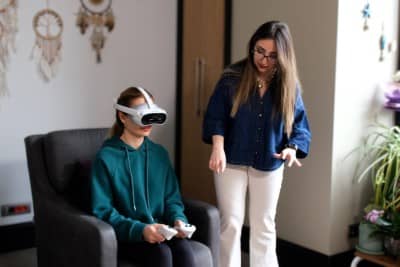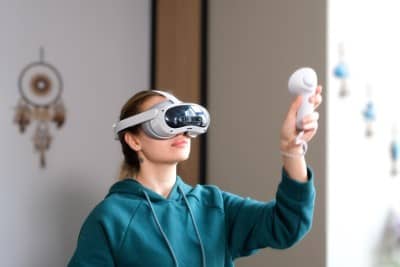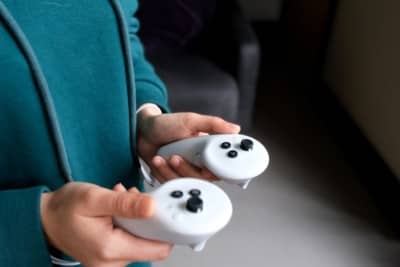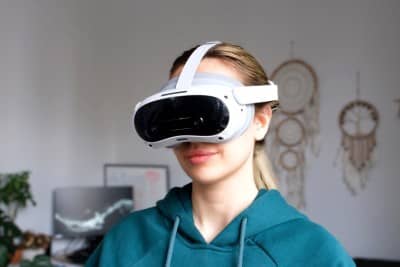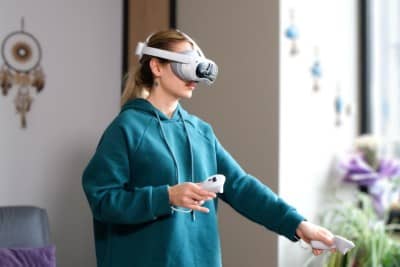Contents
Virtual reality therapy, with biofeedback supported virtual reality therapy in psychotherapy, stimuli that cause anxiety in the outside world are brought into the therapy room.
With virtual reality therapy, changes in the person's brain, respiration, body temperature and muscle movements are monitored moment by moment, enabling the person to face and cope with their fears, anxieties and obsessions.
Virtual reality therapy is realized by exposing the person to their current fears in a virtual environment as if they were alive. Virtual reality therapy is a very effective method in the treatment of the patient.
How is virtual reality a treatment method?
In order to treat anxiety and fear, virtual reality is applied only in cases where desensitization studies by talking or imagination are not enough.
Cognitive behavioral therapies are effective in anxiety, fear and especially phobias. In psychotherapy, it is not only possible to treat the person by talking to the person, but nowadays the possibilities of technology are also utilized. In the therapy of anxiety disorders and phobias, the thoughts and images that cause the anxiety and phobias are revealed and gradually desensitized. In order for the anxiety and fear to disappear completely, the person must encounter the situation that causes anxiety and fear. Until now, desensitization studies have been carried out in imagination.
How are emotions such as fear and anxiety confronted in virtual reality therapy?
The actual relief of fear and anxiety occurs when the person is exposed to that stimulus and that situation, that is, when the person experiences it in real life. For example, there are various methods and techniques to help the person realize their erroneous thoughts on the fear of dogs, to recognize their accompanying emotions and how to change them. In the treatment, virtual reality is used in the session room, but the comfort experienced in the session room cannot be experienced in real life. Virtual reality allows the person to experience that reality. The person experiences it one-on-one in three dimensions.
In virtual reality, does the person learn how to deal with their fears in real life?
The virtual reality method provides a situation that we can control because the person manages to control his/her anxiety in the presence of the therapist, but the avoidance-avoidance behaviors continue because he/she does not know what he/she will experience when faced with the real stimulus in real life. In general, people run away from uncomfortable situations. However, it progresses in a safe situation. Thanks to this method, we enable them to approach the frightening situation in a safer way under the guidance of a therapist.
How are anxiety-inducing stimuli brought into the therapy room?
During therapy, it is not possible for the therapist to be with the patient at all times and to experience the anxious issues with the client. With the virtual reality application, we bring the anxiety-inducing stimuli from the outside world into the therapy room and ensure the most appropriate exposure to the original. Therefore, virtual reality application is a method that supports psychotherapy and makes the person more ready for the last point before recovery. Because when the person can experience it in that virtual reality environment, they have taken one more step. In anxiety, when the person is exposed to the anxiety-provoking situation, anxiety increases in the person and he avoids the anxiety-provoking situations, and as he avoids, he ensures that the anxiety continues. The person needs to stay there for a while. This is what virtual reality provides.
How is virtual reality applied together with biofeedback?
Virtual reality application is applied together with biofeedback. Sometimes people say that they are afraid, but their anxiety level is not very high, but it seems very high to the person. Or vice versa, they say they are not afraid, but in fact their anxiety level is elevated and they are in physiological arousal. Biofeedback also gives concrete scales of this. Thus, while the person is experiencing some virtual reality with virtual reality goggles, the therapist is watching what he sees on the screen and how he reacts physiologically to what he sees. Thus, the person is exposed by giving directions in a way to keep him/her at maximum anxiety. As the person is exposed, after a while, the event we call extinction occurs and the emotion begins to decrease.
What is the biofeedback method?
In biofeedback treatment, we connect some sensors to the person. The computer embodies the changes in the person's physiology and brings them to the computer screen as visual and auditory signals. Two types of systems are being studied: The autonomic nervous system and the central nervous system. The central nervous system; by attaching some electrodes to the person's head, the activity of brain waves, EEG signals are directed to the computer with visual and auditory signals. Changes in the autonomic nervous system such as respiration, skin resistance, skin temperature and heart rhythm can also be monitored by the therapist on the screen through a number of sensors. When the changes in the biological functioning of the person are shown to the person again as feedback, the system uses it in its own regulation. Under the guidance of the therapist, people soon learn to recognize and control the connection between mind and body.
What is the importance of biofeedback treatment in virtual reality?
Biofeedback was already being used in our hospital before the virtual reality application. With biofeedback, the person is taught to recognize and manage their own internal processes. On the one hand, the person is made to experience the disturbing situation in the image. In fear, anxiety and obsessive-compulsive disorder, desensitization studies were carried out, but since the person could not get into his/her thoughts, there were escapes in the thoughts. Just as the person avoids his/her fears, for example, getting on the subway or an airplane, there are also escapes in thinking. Escapes in thinking could not be controlled. Thanks to the virtual reality application, it is ensured that the person fully experiences the event.
How is virtual reality applied?
The person wears a pair of glasses. The person can experience himself/herself in three dimensions as if in the environment. The therapist observes what the person is seeing at that moment on the computer screen in two dimensions. By monitoring the signals from the biofeedback, the therapist can track the increases and decreases in anxiety.
Click for Maudsley Obsessive Compulsive Test
Click for Liebowitz Social Phobia Scale Test
Augmented Reality
NP Health Group offers resources to help you and your loved ones understand and intervene. Our basic approach is to first clarify the diagnosis through comprehensive examination and neuropsychological screening. Then make a treatment plan with measurement-based methods. To apply treatment by following brain evidence with strong and adequate methods.
In addition to the Virtual Reality application for the treatment of anxiety and fear, fears and anxieties can now be eliminated with the Augmented Reality application.
Augmented reality application is a treatment method that should be applied in treatment and whose results are effective.
What is Augmented Reality and how is it applied?
What is Augmented Reality (Augmented RealIty) and how is it applied? The fears experienced by the person can be eliminated with papers read with QR codes and virtual reality glasses. For example, if you are afraid of insects or spiders, this treatment method allows you to look at and touch an insect image. Since this increases the sense of reality, more effective results can be obtained in therapies.
In Augmented Reality treatment, the therapist can determine the number or size of the insects.
Especially to treat arachnophobia, the fear of spiders, interactive augmented reality exposure therapy produces very effective results in the client.
Augmented reality application is applied by a specialized psychologist and the therapist plans a treatment according to the patient's condition. At this point, a multidisciplinary treatment is adopted.
Virtual Reality Treatment Method?
In order to treat anxiety and fear, virtual reality is applied in cases where desensitization studies are not enough just by talking or imagining.
Fear of insects and spiders, which are among the most common phobias in society, can be eliminated thanks to new generation technologies. With the augmented reality application, people with insect or spider phobia can learn to cope with their fears. According to experts, therapies that include behavioral interventions rather than traditional insight-based psychotherapies are effective in the treatment of such fears.
Phobia Treatment with Augmented Reality
The Feared Object Moves into the Therapy Room
In the augmented reality application, the object of fear is moved to the therapy room in order to expose the person to the disturbing stimulus. With the software that will enable the system to work on spider and insect phobia, the person can see the insect in three dimensions in the therapy room and perceive it as if an insect or spider is walking on their hand.
Phone is used instead of glasses
Stating that the augmented reality application is a type of virtual reality applications, experts said, "In virtual reality applications, we were enabling the person to experience some situations with the help of a pair of glasses. In augmented reality applications, we do not wear a pair of glasses. In this application, a cell phone is used. Thanks to a software installed on the cell phone, three-dimensional visual stimulation is provided in the environment where the person is currently located. The person is made to perceive the disturbing insect or spider as if it is really on their hand or arm. When the person looks at the area captured by the phone's camera, the insects appear three-dimensionally in that visual area thanks to the software on the phone."
Benefits of Treatment with Augmented Reality
Psychiatry Treatments with Virtual Reality
NP Health Group offers resources to help you and your loved ones understand and intervene. Our basic approach is to first clarify the diagnosis through comprehensive examination and neuropsychological screening. Then make a treatment plan with measurement-based methods. To apply treatment by following brain evidence with strong and adequate methods.
- Operating rooms with the latest technological features, intensive care services have the infrastructure suitable not only for neurosurgery but also for all surgical services.
- Imaging systems have a wide range including MRI, Angio CT, intraoperative applications, mobile X-ray USG.
- In the Neuromodulation Center, brain stimulation treatments are applied with the latest methods.
- Psychotherapies: The aim is to eliminate deficiencies and losses, provide emotional support, gain applicable knowledge and skills for life events, and replace maladaptive behaviors with adaptive behaviors. Neurofeedback, EMDR, psychoanalytic psychotherapy, cognitive behavioral therapy, hypnotherapy are some of the therapy methods offered at NPGRUP.
- Inpatient Treatments: Inpatient treatment is an effective option in cases where the person puts the safety of himself/herself and his/her environment at risk, where there is a life-threatening situation, and where there is resistance to treatment.
- General Medical Process: In connection with general medical services, we offer our infrastructure as a "brain-oriented" hospital.
- Implant Applications: Naltrexone Implant and Disulfiram Implant applications are performed in our hospital. The implants applied vary according to the type of substance used.
- Family Information Trainings: Addiction is a disease that affects not only the addict but also the whole family. Therefore, the treatment aims to change the family as well as the person. For this reason, trainings are organized for families to be informed about this disease and to learn appropriate behaviors and attitudes that will support their relatives to continue quitting.
- Clinical Pharmacogenetics Laboratory (Drug Blood Level and DNA Analysis): In patients taking medication, drug blood levels may exceed therapeutic values or drug interactions may lead to impaired brain function. To detect this, blood levels of the drugs used (TDM) are measured. The chance of treatment success is increased by determining the medication according to the genetic profile and monitoring the blood levels of the drugs used. Drugs that may be unnecessary or have high side effects are identified in advance and the treatment is shaped rationally. "DNA analysis" is performed if necessary.
- Electroconvulsive Therapy: During flare-ups, ECT with anesthesia can be administered during hospitalization. Seizures are induced by applying a very low electric current to the brain and the impaired electro-chemical processes of the brain are regulated.
- Transcranial Magnetic Stimulation Therapy (TMT): It is a new treatment method used in psychiatric and neurological diseases. The electrical activity of the brain is regulated by means of a magnetic field applied at short intervals to areas of the brain thought to be affected by diseases. It provides faster and stronger treatment than medication. It is used in our centers in cases of depression resistant to drug treatment. In some cases where electroconvulsive therapy cannot be applied (patient and family preference, anesthesia risk), it is applied at low frequencies in manic attacks.
- EMDR One of the specific psychotherapy techniques developed in recent years is a method called EMDR, which is based on re-processing negative feelings and thoughts about traumatic experiences in the mind.
- Hypnotherapy: By interacting with the person's subconscious mind during hypnosis, positive, significant and permanent changes in life can be achieved for the purpose of treatment.
- Neurofeedback: In neurofeedback training, information about brain waves from the person's current EEG is communicated to the person with visual and/or auditory signals and the person is asked to control certain aspects of it. Depending on the problem or need of the person, a learning environment is created by organizing a treatment protocol according to which region of the brain needs to increase/decrease the waves in which frequency. The person sees the connection between his/her current thoughts and brain waves and learns to control them in the desired direction.
- Biofeedback: It is a system that measures body temperature, skin resistance, respiratory rate, muscle tension and heart rate with special electrodes and visualizes the relationships between the person's bodily sensations and thoughts.
- Biofeedback Supported Virtual Reality Therapy: With biofeedback-assisted virtual reality therapy in psychotherapy, stimuli that cause anxiety in the outside world are brought into the therapy room. While the person experiences the anxiety-provoking situation with virtual reality glasses, changes in the autonomic nervous system are monitored moment by moment thanks to the biofeedback method. Thus, it is ensured that the person confronts and copes with his/her fears, anxieties and obsessions. The person is fitted with a pair of glasses. The person can experience himself/herself in a three-dimensional environment. The therapist observes what the person sees on the computer screen in two dimensions. By monitoring the signals from the biofeedback, the therapist can track the increases and decreases in the client's anxiety.
- Rehacom (computerized training modules): A personalized attention training program can be made to regain mental skills or to increase existing skills. Rehabilitation of cognitive skills such as planning, organization and attention management is done using computerized training modules.
- Sleep Laboratory: A sleep laboratory was established with a sleep room, phototherapy room, sleep deprivation room and central digital examination system. Sleep laboratories are an activity that requires a joint disciplinary approach of neurology, ENT, chest and psychiatry specialists. Psychiatric approach is often required in treatment. Laboratory responsibility is carried out with this awareness.


